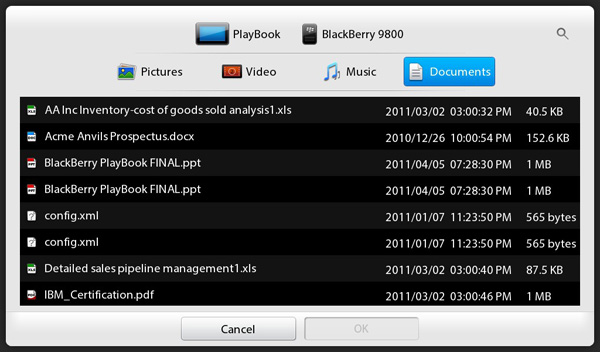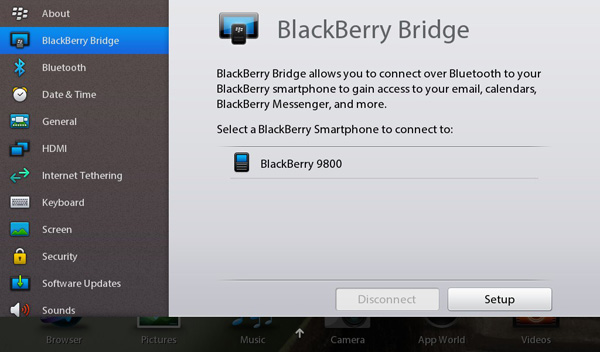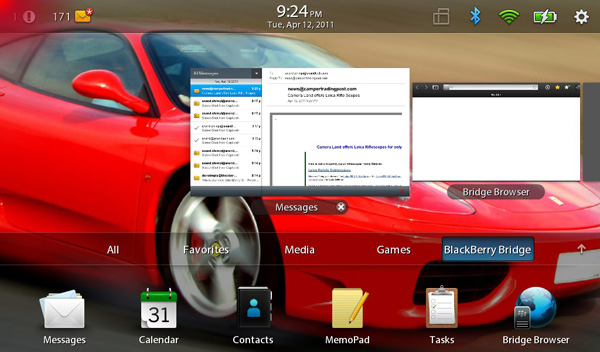The BlackBerry PlayBook Review
by Anand Lal Shimpi on April 13, 2011 9:00 PM EST- Posted in
- Tablets
- Smartphones
- RIM
- BlackBerry
- PlayBook
- Mobile
BlackBerry Bridge
The first era of the mobile revolution was about apps. Quantity, quality, method of delivery, everything that related to the apps on these devices is what really helped accelerate adoption of platforms like Android and iOS. While we're not quite done with the first era, the next era will be one of synergy between devices. Today there's simply no good way to seamlessly share all of your data (both static and active) among all of your computing devices (PC, tablet and smartphone). Cloud services help bridge the gap but what about some of the basic use cases? Let's say I've got a few tabs open in Chrome on my PC and I decide to take a break and read those websites on my tablet. There's no way to quickly take my current operating environment with the apps/tasks I've got open and transition them to another device.
Everyone who is anyone in the mobile space is working on device synergy, although very few attempts have been demonstrated publicly. HP's touch-to-share is an early example of synergy between devices, although it's presently limited to sharing URLs between webOS phones and the TouchPad. You can see how HP is in a good position however to extend that sort of synergy to its desktops as well. The same goes for Apple. Google wouldn't have too hard of a time doing it, assuming you're running mostly web apps on your PC and store state in the cloud.
RIM's first attempt at device synergy targets its loyal (whether forced or by choice) customer base: BlackBerry users. In the enterprise, the BlackBerry does a handful of things extremely well. The features are apparently attractive enough to actually force some users to carry two smartphones: an iPhone/Android phone for personal use and a BlackBerry for work.
The PlayBook solution is called BlackBerry Bridge. At a high level it's a 256-bit AES encrypted link over Bluetooth between the tablet and any BlackBerry running OS 5.0 or later. This encrypted link is then used to manage data stored on the BlackBerry using the PlayBook. In essence, the PlayBook becomes a larger window into your BlackBerry.
To enable BlackBerry/PlayBook interoperability you have to do two things. First, on the PlayBook, go to the BlackBerry Bridge settings page and enable the option. You'll be taken through steps to get the Bridge app onto your BlackBerry and finally pair the two devices. RIM just enabled Bridge support within the past 24 hours so the process is a bit more complicated for reviewers than it will be for customers. While an end user should be able to just scan the QR code displayed on the PlayBook with a BlackBerry, I had to login to RIM's beta site and manually download the app as well as jump through a few additional hoops.

The pairing process is pretty simple, pretty typical for a Bluetooth pair. You'll get a pin on both devices, make sure they match, hit go and you're all synced up.

Once paired, you can lock your BlackBerry and set it aside. The PlayBook now gives you full access to messages, calendar, contacts, memos, tasks and even your BIS/BES connection for browsing the web. Again, the link between the BlackBerry and PlayBook is 256-bit AES encrypted so you don't sacrifice any security in doing this.
The default PlayBook home screen has four categories for apps: All, Favorites, Media and Games. Enabling Bridge adds a fifth category: BlackBerry Bridge. All apps in this category pull their data from your BlackBerry and don't store anything on the PlayBook itself. Once you end the Bridge session, all data goes away. Even when you're using the PlayBook anything that comes from your BlackBerry is stored temporarily in memory and encrypted during its stay on the tablet. RIM's goal here is to allow the PlayBook to be introduced into a secured enterprise environment without compromising that security.
All internet/intranet data you access through a BlackBerry Bridge app goes over your BlackBerry internet connection, which means it all goes through BIS/BES and is thus fully encrypted. There's obviously a performance penalty, but if you need the added security, it's there.
BlackBerry Bridge apps are all choppier than regular PlayBook apps, something you notice even when you scroll over them in the task switcher. Scrolling over PlayBook apps is typically pretty smooth but get to the first active Bridge app and the animation frame rate drops a bit.
BlackBerry Bridge Messages
By default the PlayBook has no thick email client, something RIM will rectify this summer in an update to the PlayBook OS. BlackBerry Bridge however gives you full access to all messages received by your BlackBerry via the Messages app.
The Messages UI is pretty standard for a tablet email client. There are two columns, one for your inbox and one for the currently selected message. In portrait mode only one column is visible at a time.
You can do most of the basics from the Messages app: search, compose, delete, forward, reply, flag and move. Curiously absent is the ability to mark all items as opened like you can on a BlackBerry. You can go into multiple-selection mode just like on Android/iOS and mark items as opened that way, but there's no mark all option unfortunately.

You can send attachments via Bridge from either the PlayBook or BlackBerry, but you can't open them currently
Selecting multiple items in the Messages app is considerably slower than other aspects of the PlayBook UI. Given how fast and smooth everything else is, any sluggishness is that much more pronounced.
Calendar, Contacts, MemoPad and Tasks
The Bridge Calendar app isn't particularly beautiful, but it's functional. You can create and view appointments, which are again stored only on your BlackBerry. Unfortunately any reminders set in your calendar don't currently propagate to the PlayBook, they'll appear on your BlackBerry but not on the tablet. RIM clearly has work to do here.
The Contacts, MemoPad and Tasks apps are all self explanatory. Any data you create/access here lives solely on the BlackBerry, the PlayBook is simply a more user friendly viewport into your work world.
The notification problem exists for the Tasks app as well. You can have a reminder set for a task but you'll only be notified on your BlackBerry.
BlackBerry Bridge Browser
Remember that all Bridge apps use your BlackBerry's encrypted internet connection to get to the outside world. If you need that added layer of security for web browsing, just fire up the Bridge Browser.
The Bridge Browser app itself is just as functional as the standard PlayBook browser. You can even run the PlayBook's browser and the BlackBerry Bridge browser in parallel, using one for unencrypted web traffic and the other when you need additional security. The only difference between the two browsers is what path your packets take: WiFi or Bluetooth-to-BlackBerry-radio.












77 Comments
View All Comments
gentrfunk - Saturday, April 16, 2011 - link
Hi Folks,Anyone have any info on how messages are passed back and forth between the kernel? I'm interested in the fact that microkernel systems typically had problems in some cases locking up the cue with multiple rapid input (e.g. mouse clicks, etc)...
any thoughts?
mavricxx - Tuesday, April 19, 2011 - link
The thing about this tablet is that you gotta give it time to mature. Right now is at its infant state where there are little apps, and the software is still being refined. I will say that the best thing about this tablet that sets it apart from Android is that you won't have different iterations of say Honeycomb 3.0 and having to wait forever for updates. One good thing RIM has going for it is its reputation for kicking out updates. Hopefully, it kicks it in turbo and lots of GOOD apps start coming out. Another thing I'd like to point out that NONE of the reviews have applauded RIM for is the standard MicroUSB charger which all phones use now a days. This is a big deal as if you happen to lose your charger its no big deal. I hope to see a lot of cool and useful gadgets for this device as well. One major thing I see that RIM screwed up besides the whole email/calendar/contacts thing was the absence of expandable memory; Had they added a FULL size SDXC card support they would have blown this thing to another level. A couple of things I'd like to see with the upcoming updates are: Free turn-by-turn Nav, universal search and maybe some full free FPS(Call of duty)/racing(need for speed)/action(Grand theft auto)/RTS(Company of heroes) games to make this thing worthwhile to buy. Lastly, I think RIM could have made this thing more desirable to purchase as well by including headphones, USB adaptor and an HDMI adaptor.worldbfree4me - Tuesday, April 19, 2011 - link
This year, Tablets will probably be only 2nd to HDTV's in Black Friday advertising. I like my iPad 1, but it is lacking in a lot of areas. I think that the features I crave on the HTC View (Stylus Input), Black Berry and HP WebOS (Bridge), and True Multitasking will eventually find their way onto the rest of the pack and by this time next year we will finally see complete Tablets with I/O galore (HDMi Mirroring,USB 3.0, BT 3.0, MicroSD etc). With Amazon leading the Cloud Storage Charge, on device storage will become not so this keeping retail prices nominal. Even right now because of my distrust in Apples’ walled garden. I have no Music or Videos stored locally on my iPad. Sugar Sync, Evernote, Drop Box, and of course Gmail rounds out my storage albeit virtually.Thanks for another great analysis!
mblair - Wednesday, April 20, 2011 - link
The RIM playbook is a game changer. The slick, easy to use interface and true multi-tasking make it a dream to use. Its Flash execution is flawless. I was surprised how many times I needed Flash. It made my Ipad almost useless some of the time.The best feature for me is Blackberry Bridge. A Wi-Fi tablet but with my blackberry in my pocket and Bluetooth, I can operate 3G. I can't do that with my Wi-Fi only Ipad! And I don't need two user accounts or an extra monthly fee.
It did not take me long to get used to the Blackberry paradigm. Now I take it everywhere, it is small enough to be truly portable. Battery life is OK, not spectacular but pretty good. The video rendering is world class.
I use gmail so the browser is all I want or need most of the time. I have my Blackberry for email from work and when tied to the Playbook I can use the larger screen seamlessly. The Playbook gives me all I want.
Good bye Apple. It has been a slice.
I love it. I have given my son the Ipad. He wants a Playbook. Maybe later.
Michael Blair
Shadowmaster625 - Friday, April 22, 2011 - link
This is a screenshot from a flash game running on IE9: http://grab.by/9WxQThere are huge gray sections that are failing to render or whatnot. The sections grow over time. It looks really bad. This doesn't happen on firefox. But the game does run faster on IE9, for whatever that is worth... obviously not much.
exprimarelibera - Monday, July 18, 2011 - link
I bought one today, more than four months after this article and still no email application available. I'm pretty disappointed, after all that's what made RIM what they are.http://www.exprimarelibera.ro/2011/review-m-am-juc...
No Netflix Streaming - Sunday, November 27, 2011 - link
This tablet DOES NOT STREAM NETFLIX. The Netflix app only queues discs. Contact Blackberry Before You Buy and Demand a Netflix Streaming App.